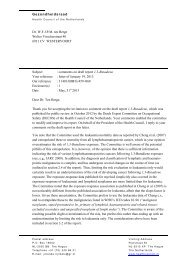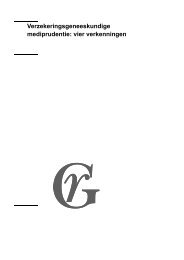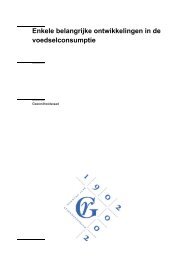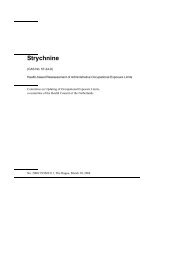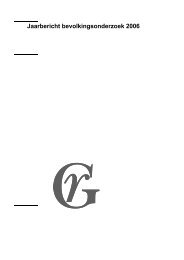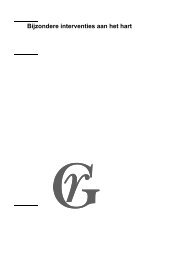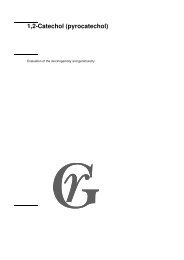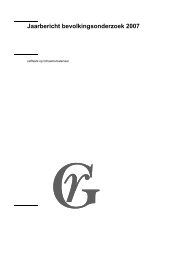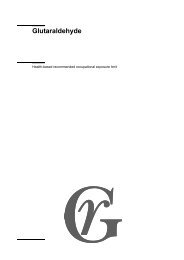Health Council of the Netherlands Reports 2003 - Gezondheidsraad
Health Council of the Netherlands Reports 2003 - Gezondheidsraad
Health Council of the Netherlands Reports 2003 - Gezondheidsraad
You also want an ePaper? Increase the reach of your titles
YUMPU automatically turns print PDFs into web optimized ePapers that Google loves.
safety <strong>of</strong> <strong>the</strong> procedure deserves careful attention, also in case <strong>of</strong> mobilised blood<br />
donors. Increased use is also being made <strong>of</strong> umbilical cord blood, though <strong>the</strong><br />
relatively small number <strong>of</strong> stem cells collected per donation is a limiting factor. It<br />
is <strong>the</strong>refore important that researchers should explore <strong>the</strong> possibility <strong>of</strong> obtaining<br />
larger quantities in <strong>the</strong> laboratory by means <strong>of</strong> cell division. The development <strong>of</strong><br />
methods to expand <strong>the</strong> number <strong>of</strong> stem cells, regardless <strong>the</strong> source, may alleviate<br />
<strong>the</strong> shortage <strong>of</strong> donors. By that shortage, a suitable (tissue-matched) donor is not<br />
available for a ra<strong>the</strong>r large number <strong>of</strong> patients, especially migrants.<br />
Ano<strong>the</strong>r way <strong>of</strong> alleviating <strong>the</strong> donor shortage could be to store larger<br />
quantities <strong>of</strong> cord blood for general use via a cord blood bank. Storage for<br />
possible autologous use is impractical, however, since <strong>the</strong> likelihood <strong>of</strong> such use<br />
actually taking place is remote (less than 1:10,000).<br />
Alongside <strong>the</strong> shift from bone marrow to mobilised blood and, to a lesser<br />
extent, umbilical cord blood, <strong>the</strong>re have also been developments with regard to<br />
<strong>the</strong> selection <strong>of</strong> donors and in treatment techniques. The selection <strong>of</strong> donors can<br />
be improved with <strong>the</strong> aid <strong>of</strong> new laboratory tests (molecular typing), which allow<br />
large numbers <strong>of</strong> donors to be matched to suitable transplantees. Fur<strong>the</strong>rmore,<br />
increasing use is being made <strong>of</strong> <strong>the</strong>rapeutic methods that partially spare <strong>the</strong> bone<br />
marrow. As a result, <strong>the</strong> mortality and morbidity associated with stem cell<br />
transplantations have declined.<br />
The number <strong>of</strong> transplantations performed world-wide has fallen in recent<br />
years. Less use is made <strong>of</strong> autologous cells than a few years ago, mainly due to<br />
disappointing results in patients with solid tumors. However based on recent<br />
results in a certain group <strong>of</strong> breast cancer patients, an increase is to be expected<br />
over <strong>the</strong> coming years.<br />
The use <strong>of</strong> allogeneic cells remains virtually unchanged. This fall in <strong>the</strong><br />
number <strong>of</strong> stem-cell transplants is expected to be partially <strong>of</strong>fset by an increase<br />
in allogeneic stem-cell transplants, prompted by a broader interpretation <strong>of</strong> <strong>the</strong><br />
indication for intervention. Partly as a result <strong>of</strong> <strong>the</strong> donor shortage, however,<br />
<strong>the</strong>re is unlikely to be any substantial increase in <strong>the</strong> overall total in <strong>the</strong> near<br />
future. No such rise can be anticipated ei<strong>the</strong>r in <strong>the</strong> number <strong>of</strong> transplants in<br />
children. Consequently, <strong>the</strong> current number <strong>of</strong> centres at which stem-cell<br />
transplants are performed is considered to be adequate for <strong>the</strong> time being.<br />
Legislation <strong>of</strong> <strong>the</strong> donation <strong>of</strong> stem cells is spread over different laws.<br />
However, <strong>the</strong> mandatory rights and <strong>the</strong> protection <strong>of</strong> donors are warranted<br />
sufficiently. Also <strong>the</strong> safety and quality <strong>of</strong> <strong>the</strong> stem cells to be used are<br />
guaranteed legally in a sufficient manner. The same applies to <strong>the</strong> quality <strong>of</strong> <strong>the</strong><br />
institutions concerned and <strong>the</strong> expertise <strong>of</strong> <strong>the</strong> pr<strong>of</strong>essionals involved.<br />
18 <strong>Health</strong> <strong>Council</strong> <strong>of</strong> <strong>the</strong> Ne<strong>the</strong>rlands; <strong>Reports</strong> <strong>2003</strong>




